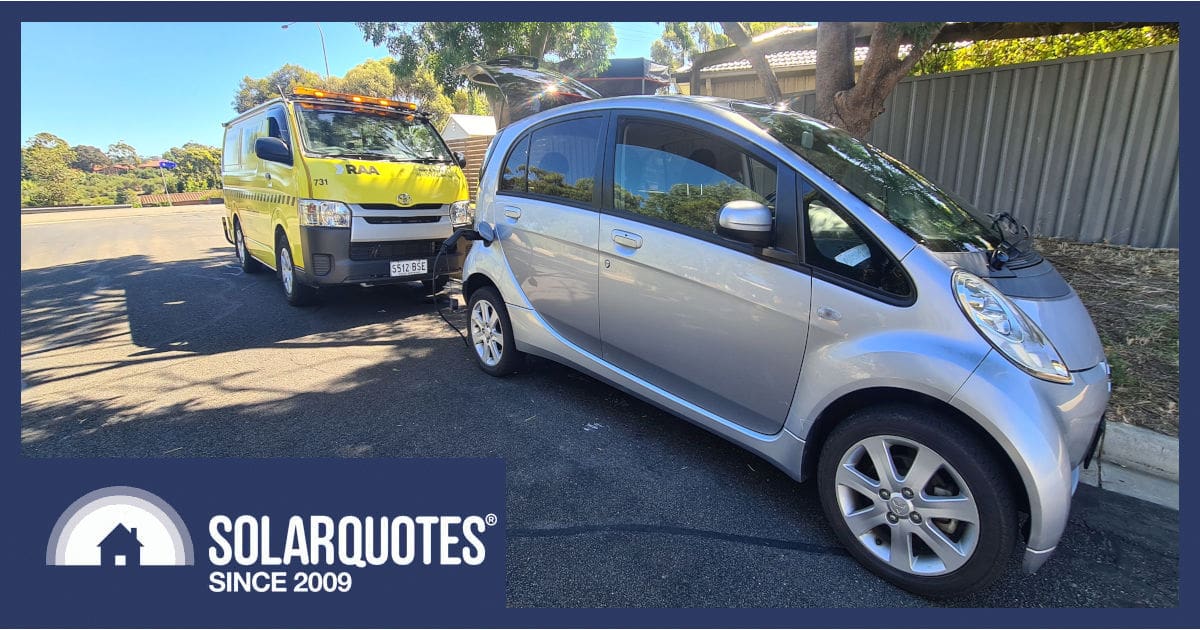
As I wrote last week, I’ve recently picked up a really cheap electric vehicle. Since then, I’ve been testing out the battery, mulling over why we feel the need to name cute cars… and trying out the RAA’s new emergency charging service for EVs. Oops.
Here’s a little insight into my journey so far as an iMiev owner, for the second time around, and what happened when things went awry.
Naming Rituals: Forming Bonds With Cars Is Normal, Right?
While I have always been a car enthusiast, I’ve never really named my cars (the exception being whatever car I happened to be racing at Mallala, which I usually called: “Whoa, Betsy”, as she squirmed under brakes, trying to wash off 100mph into a hairpin).
The iMiev is such an endearing little thing, though. My first I named Irene, and my latest purchase became Greg the Golf Ball, because of the many dents left in the roof after a hailstorm. Equally, however, he could be called ‘Alf-Price Harry.
Tesla encourages you to name your EV, and I think it’s an encouraging trend that pushes people to actually look after their cars. EVs should last a good deal longer than your average combustion engine vehicle, and caring for them is a no brainer in environmental terms.
Getting A Feel For Battery Capacity
With double the mileage in a marginally older car, it’s unsurprising that Greg’s battery isn’t as good as Irene’s. By the seat of my pants, he’s not quite as zippy and doesn’t quite recharge as much going down the hills, but the ‘Guess-O-Meter’ range prediction of 75km on the dash does track well against kilometres covered.
From 16kWh originally, the monitoring app says we’re running 75% state-of-health for Irene, so we’re down to about 12kWh — or close to a new Tesla Powerwall. In real-world terms, that has translated into an 86km journey with me driving modestly and arriving comfortably.
Greg, on the other hand, is showing 61% state-of-health, or 9.7kWh — almost bang on the modest-sized, three-module battery that Sungrow offers with its 5kW solar hybrid system for a house. With less sympathetic highway driving, (which saps performance with aerodynamic load) we made 67km, at which point I was relieved to have made my destination.
Pushing The Boundaries of Range
Despite a year’s worth of uneventful motoring with Irene, it was only the third time I drove Greg that I ran out of battery. Hooray, new achievement unlocked!
Initially, we did a couple of short runs, and on the following day I set off for the office with a little over half a battery remaining.
I took Trev the manager out for a little test ride, and as I drove home again in the traffic, I experimented with pressing the air conditioning button and watching the range indicator immediately drop by 4km. With shenanigans like that, perhaps I got what was coming to me.
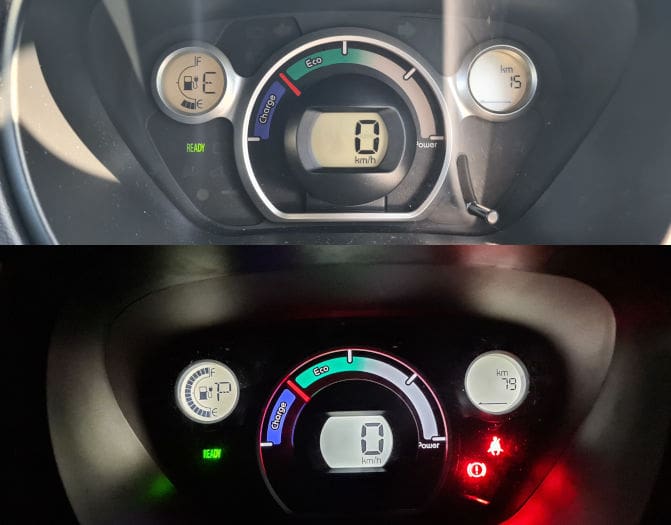
Vintage EV instrument cluster. Fuel gauge on the left, Guess-o-meter on the right. I normally set the trip meter to display distance travelled.
Gambling With The Guess-O-Meter
The Guess-O-Meter gets its (unofficial) name from stunts such as climbing Flagstaff Hill, and then finding that 138-metre ascent over 3km actually eats up 10km to 12km of predicted range.
I could have stopped for a free charge at Tonsley, but I actually wanted to get home with a near-flat battery, to run another test. So with 14km remaining, I turned up the hill and pinned the throttle open.
While my wife has commented about how zippy Irene is on this stretch, Greg responded casually, and having climbed the steep part, he got more and more… casual. Eventually, I wasn’t comfortable being on a 70km/h dual-lane road and turned into a side street.
The RAA’s First EV Rescue Customer
I knew the RAA had an EV charging van, they’d been promoting it on their socials. And while I’m not 100% sure I was the first to use it, they’re not denying it.
I called them up, and after a couple of mildly embarrassed ‘umm’s and ‘ahh’s, I had a rescue planned for within the hour. A callback followed, from someone asking exactly what model I had, because an iMiev is an older EV with a type 1 charging plug — something I’m glad they were across.
Bear in mind that in the past I have made an RAA mechanic bring me a piece of wire and some gasket cement to fix a fuel pump, and cajoled the country service bloke into helping me drive a tek screw through a broken fan belt tensioner half way back from Melbourne. I wouldn’t be without them.
Nerding Out Over Hardware
When the van arrived I got to have a stickybeak at what I immediately recognised as a Victron off-grid power system. Noice.
The road service mechanic had only just done some training, but I was able to run over the finer details with him on how it all worked.
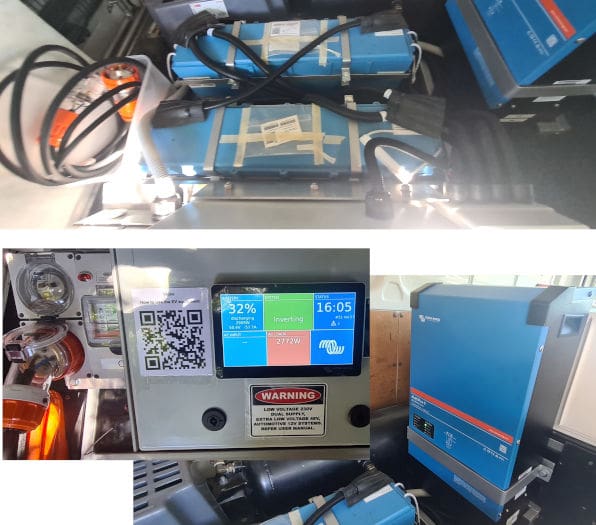
Stick your head in the side door to see two batteries in the middle, the inverter to the right and touchscreen in the centre, with input and output sockets on the left.
Basically, here’s what we had:
Two x Victron Lifepo4 25.6V 200Ah batteries:
These provide 10.2kWh nominal or 8.2kWh useable storage. Roughly speaking, that’s 50km of range in the tank — enough for the RAA to rescue three cars, they say.
One x KWIK Portable Type 2 EVSE | 32 Amp | 7kW:
With an extension cord to suit.
One x Victron Cerbo Touchscreen.
One x Victron Multiplus 48/8000 Inverter to supply the power:
While this seemed to work fine, I would have specified a better machine — at 40°C the multiplus is only rated for 5.5kW. I understand Victron has a lovely screen to display information, but there are Australia-made inverters, rated for less, that actually do more.
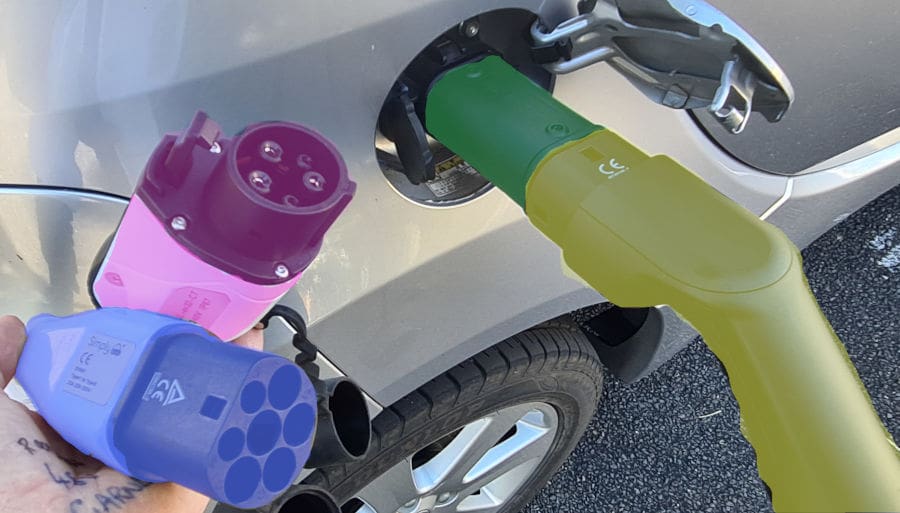
This BYO lead for public charging has a type 1 plug for older EVs (pink) and a type 2 plug for untethered charge points (blue). The yellow type 2 plug is found on a tethered charge points, so older EV owners need an adaptor (green). Sadly, this is the magic of photo editing. If only they were colour coded in real life.
Plugging Standards Almost Brought Us Unstuck
I had a cable with me that allows the car to charge at an untethered public pillar. However this cable can’t be used as an extension cord for a tethered charging station.
What I needed was an adaptor to get the tethered lead extending from the RAA van into my type 1 vehicle. Luckily there was one hiding in the van. And with that, legacy EVs are saved.
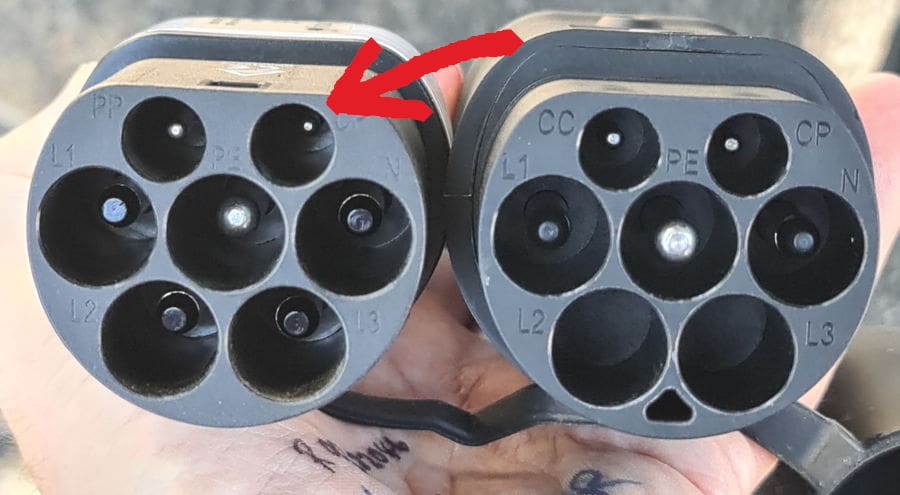
That pilot pin is just a little further recessed into the hole, so your untethered EV charging lead can’t be used as an extension cord.
Just 25 Minutes Later, We Were Back In Business
The whole process probably took a little longer than usual, because we were having a good old conversation. But after 1.23kWh donated, and with three bars on the fuel gauge, I headed home — with an RAA escort for 3km just to be sure.
Overall it was a great service; one that should bring comfort to anyone with new-EV anxiety.
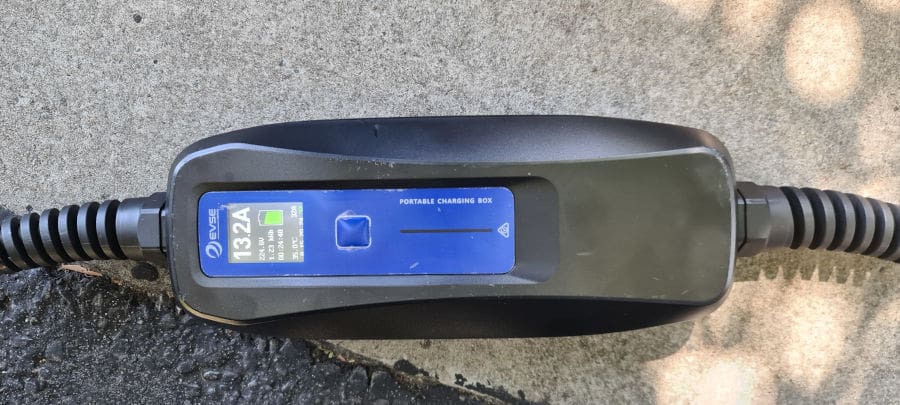
The KWIK Portable Type 2 Charger showing 13.2amps at 230VAC as Greg charges from the RAA van.
What Could Be Done Better?
Protection from the elements
A simple improvement would be investing in an awning to shield both operators and equipment from the elements.
Also, while the weather on this particular day was gorgeous, modern vehicles are designed to be air conditioned. With so much glass, the risk of overheating is real. I would pack a weighted blanket in the van to shade the windows on the stricken vehicle. As the saying goes: “dogs die in hot cars”.
Operators could also pack some drinks. If you’ve already been stranded for an hour, there might be a real need for hydration.
Solar powered rescue vehicles
On general principle, I’d suggest a kilowatt or two of solar on the van roof. Panels are easy to DC couple to the battery, making the rescue battery a self-filling jerry can.
Recharging en route
Having a DC-to-DC charger would also enable the 12volt system in the van to top up the 48v rescue battery while driving from job to job.
And having a different EV charging adaptor on hand would also allow RAA drivers to pull up and recharge the rescue battery at an ordinary EV charging station, twice as fast as plugging in back at base, without the added travel.
What Did We learn?
While this wasn’t the experiment I was planning on this particular day, it was worthwhile all the same.
I may have pushed Greg’s boundaries a little far, but I learnt how this battery behaves at a low state of charge and how it’s different to what I’ve come to expect from a healthier set of cells. Best of all, I know what to do, and how much leeway there is if we push the envelope.
All in all, I was impressed by the RAA’s service; I got first-hand experience of an EV rescue operation, and a good look at some mobile charging tech; and I got some material for a blog. As far as breakdowns go, you can’t ask for much more than that.

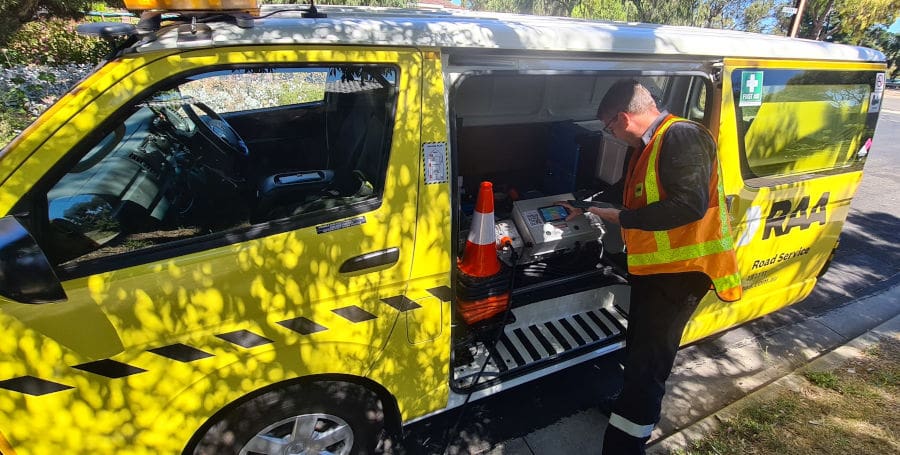
 RSS - Posts
RSS - Posts



We have done the same thing in our Imiev: Returning from a ´trip´ (not far in an Imiev!) we ran out on the last hill about 2Kś from home. I had to wait twice for the battery to regain a bit of capacity to get to the top of the hill, then left the car & walked home. Took an extension lead & Granny to the car (parked at a friends house, when they were away). Plugged in at an outside PP & left for an hour (about 2Kw of charge). Expensive charge, cost me a bottle of wine!
The only other time the Imiev stopped was when the 12v battery failed. As an aside, every time I take the Kona for service, they say the 12v battery requires replacement (they use a starting load tester!). Well over 12 months now & battery still OK. How many 12v batteries are changed unnecessarily?
I carry a Granny (now an 8-10-12-16A Chinese EVSE), a 10>15A ELCB adaptor, & a 25M 15A (genuine 2.5 sq mm cable) Extension cable in the Kona. Good for camping at Powered campsites, or emergencies. 10A+ use needs care: the lead can have no loops, all connections must be tight (& I check them at 15min, then periodically until I am sure there is no overheating). Even at 8A I have seen a pp overheat. Fire is a definite risk. Screw retained sockets are an advantage (the type that has a screwed ring to hold the plug to socket).
You’re all over it Doug,
I normally have a granny charger on board on general principle, means you can guerilla charge in a $30/day CBD car park, but in this instance I didn’t go door knocking to see who’d like $5 for less than a dollars worth of energy.
Considering the idea of the rescue van having some roof mounted solar panels to charge when out and about,… maybe you could carry a solar blanket of your own to top up your own battery if you run out,….then no need to call on the RAA at all. What better than a self filling jerrycan?
My first Electric car was a i-Miev and back in 2012 public charging was quite rare, so I nearly got into a similar situation going up the freeway.
Fortunately nowadays, if you carry your Mains granny charger you only need to find a friendly EV driver with Vehicle to Load 230 V AC out.
My Ioniq 6 has a 15A/ 230V output in the back seat, along with a 15A/ 230V output adapter for the type 2 connector. Ioniq 5, KIA Niro EV and EV6, EV9 have the same.
BYD and MG have similar capabilities too, so hopefully in the future helping stuck EV drivers becomes as common as offering a jump start off the 12V starter battery.
Why hasn’t someone designed/built/marketed the EV self rescue? Concept copyright.
A small (?) solar panel AND wind turbine could be carried just like the ubiquitous spare wheel!
Ran out of power? Well, it might take a while, but you could get yourself going again.
Hell; why not (apart from theft) set it up every time you park?
At least you’d have the ability to point the panel within the 40 degree Angle Of Incident light which would maximise it’s output (as opposed to flat on the car’s roof). See http://www.solarabcs.com/about/publications/reports/aoi/pdfs/ABCS-29_AOI-SR-3-4.pdf
Cheers peeps!
Marrk, why bother? Carry Granny, an adaptor & Extension. There is usually somewhere to plug in. The whole kit weighs less than 10Kg. (& I just bought a Chinese EVSE for well under $150 fm Marketplace)
Simpson Desert
what is a granny?, in EV context
The smallest type of EVSE (electric vehicle supply equipment) is often referred to as a granny or a brick.
…”There’s usually somewhere to plug in” ?? huh??
No there’s not. Often, even with the standard powerpoint trickle charger onboard, or a 3phase charger on board, often there would be nowhere to plug in if your EV runs out of juice, unless all you do is drive around the suburbs. This is the whole point of range anxiety; and the need for hundreds of RAA EV charging vans.
The cause of range anxiety is the lack of public charging infrastructure. The constant argument on this site, that most people charge at home, is not the solution to range anxiety, it is part of the cause.
Presumption 1. Most people can charge their EV at home in their driveway or garage, is simply wrong. The stand alone home with a driveway / garage is rapidly becoming something that only the wealthy can afford to live in. The only reason this presumption holds any water is because the public EV charging infrastructure is not fit for purpose.
Presumption 2. Most people only want to use their EV to commute within range of their vehicles battery, is wrong. This presumption is caused by EV charging infrastructure limitation and is actually causing the slow roll out of public EV charging.
Presumption 3. That EV owners are out there doing long distance trips without a charging care in the world, is wrong. We don’t us our EV for long trips because its not viable unless you’re some kind of main highway only and mainstream hotel chain lover. We’re not. We drive a diesel vehicle on long trips because charging our EV is impossible to go anywhere interesting.
Presumption 4. Most EV owners are able to install solar charging at home to charge their EV. Wrong. Not only for the reasons above in Presumption 1, but also because renters, short term housing owners and low income earners cannot install solar in the first place.
All of these presumptions are actually the cause of range anxiety and the cause of the slow roll out of public EV charging infrastructure in Australia.
95% of EV owners charge at home going on the last figures I saw.
We need a cultural shift that normalises plugging a car in *anywhere* you can park one, during the day especially.
Exactly. The reason 95% of EV owners charge at home is that the public charging network is so minimal, so unreliable and so inconvenient. And it’s not the charging time once your plugged in that’s the problem either, it’s the frustrating wait times if the (usually single or double) EV chargers are occupied.
#1 Will only be false if urban density reaches the point that inner city apartment dwellers and ultra-dense suburbia exceeds the population of regular suburbia and non-urban areas. Oh I shouldn’t overlook the packed multi-car rental houses. Since most people think in terms of petrol or diesel range, and petrol station ease and availability, is it relevant?
#2 Most people expect to travel the distance they need or want to travel. If EVs aren’t fit for the purpose then petrol, or diesel, remains the better option, as you yourself note.
#3 An interesting point. Your concern also suggests that EVs remain unfit for use outside cities.
#4 Five million Australians live in postcodes with half or more of all households have solar, 750,000 live in postcodes with 70% or more of households with solar systems, and as of late 2021 3,000,000 households had solar – though I’m sure newer figures are better. Those who can’t or won’t install solar are the ones that will have to keep supporting the grid, which get increasingly expensive as solar owners minimise their consumption, solar battery owners completely cut their consumption, and some opt out of the grid altogether. Does this mean the segment of the population that can never acquire solar will likewise be functionally locked out of the EV market?
The EV issue is a similar sort of chicken and egg problem as faces Toyota and hydrogen technology. Without hydrogen refueling stations there’s no point buying hydrogen cars. Without people buying cars there’s no business case for anyone, other than car sellers, to build hydrogen stations. In my area for instance the closest charger is over 50 kilometres away, unless you’re prepared to use one of the rare 3 phase or single phase options around. Odds of someone building an EV recharging station here? Zero!
Interesting points George.
You’ll note that Toyota have been pushing back against fuel standards in Australia and are strangely absent from the field in terms of building hydrogen infrastructure. In the US they’re almost giving away hydrogen cars and Shell have closed the bulk of their filling stations in California, there are none in other states(?) So I’d be happy if someone could clarify, but the world’s 16th biggest economy now has about 10 hydrogen fillers?
It’s a stark contrast to Tesla, who build EV fast chargers all the time.
The difference I think is mainly that Tesla is tapping the distribution network that’s already in place. Unlike 120 years ago when EVs were last a significant part of the transport fleet, and motor spirit was bing shipped in wooden boxes, by horse drawn wagon to your local chemist, there is electricity everywhere now.
Last I checked hydrogen was available to the public in Geelong, with a handful of industrial sites elsewhere.
3 phase power points aren’t that hard to find, what’s really needed is a cultural shift that opens people to the possibilities. Advertise your 3ph power point and people will come and use it, pay you, or just frequent your town/business.
Have heard that BYD vehicle to load does not do this. Something to do with earth.
If the EV has an earth leakage function it may not work because anything with an MEN link (like a house switchboard) is seen as a fault which trips the “safety switch”
Great read Anthony, and very glad to hear that the RAA top-up service worked out!
I can add some detail to the design of the RAA mobile EV charging system:
– A DC-DC converter is included within the main electrical cabinet to trickle charge the rescue battery from the vehicle 12V system
– There are also solar inputs, so yes it’s a great option to add a panel or two to the roof.
– The expected run-time of the system is only ~15mins (at 7kW), so the inverter can perform above its ‘continuous’ rating at elevated temperatures and happily deliver the full 7kW (single phase) accepted by most modern EVs. All about optimising the design. In your case I guess the charge rate was 3.6kW, so it wouldn’t have stressed the system.
– Selectronics inverters are great and I have used them before, but for this application the Victron was well suited.
– A bit more work would be required to enable recharging of the system from a public EVSE, but definitely possible in future if it helps operations.
Other than our family EV, I still occasionally drive my converted EV with 60km range and an extension cord carried at all times, so I also know the ‘fun’ of pushing the boundaries!